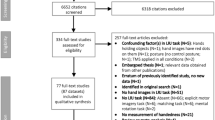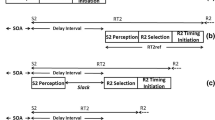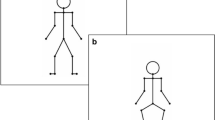Abstract
The present findings demonstrate that when participants are provided a Lissajous display with cursor indicating the position of the limbs and a template illustrating the desired movement pattern they can rapidly (10 min) and effectively (continuous relative phase errors and variability ~10°) tune in a difficult 5:3 bimanual coordination pattern and without additional practice re-tune their responding to an equally difficult 4:3 coordination pattern. The findings indicate the extreme difficulty associated with producing complex polyrhythms in previous experiments has been due to split attention when Lissajous feedback has been provided and inability of the participant to detect and correct coordination errors when only provided vision of the limbs. Effective transfer to the 4:3 polyrhythm without previous practice suggests that the perception–action system’s capabilities are extensive. The present findings when viewed in the context of recent experiments using similar protocols suggest that much, but not all, of the difficulty associated with producing a variety of bimanual coordination tasks should be viewed in terms of perceptual constraints imposed by the testing environment.


Similar content being viewed by others
References
Aschersleben G, Prinz W (1995) Synchronizing actions with events: the role of sensory information. Percept Psychophys 57:305–317
Baldissera F, Cavallari P, Marini G, Tassone G (1991) Differential control of in-phase and anti-phase coupling of rhythmic movements of ipsilateral hand and foot. Exp Brain Res 83:375–380
Bingham GP (2004a) A perceptually driven dynamical model of bimanual rhythmic movement (and phase perception). Ecol Psychol 16:45–53
Bingham GP (2004b) Another timing variable composted of state variables: phase perception and phase driven oscillators. In: Hecht H, Savelsbergh GIP (eds) Advances in psychology: time to contact. Elsevier, Amsterdam
Bingham GP, Schmidt RC, Zaal FTJM (1999) Visual perception of relative phasing in human limb movements. Percept Psychophys 61:246–258
Bingham GP, Zaal FTJM, Shull JA, Collins D (2000) The effect of frequency on visual perception of relative phase and phase variability of two oscillating objects. Exp Brain Res 136:543–552
Bogacz S (2005) Understanding how speed affects performance of polyrhythms: transferring control as speed increases. J Mot Behav 37:21–34
Boonstra TW, Daffertshofer A, Breakspear M, Beek PJ (2007) Multivariate time-frequency analysis of electromagnetic brain activity during motor learning. Neuroimage 36:370–377
Buchanan JJ, Ryu YU (2005) The interaction of tactile information and movement amplitude in a multijoint bimanual circle-tracing task: phase transitions and loss of stability. Q J Exp Psychol 58A:769–787
Buchanan JJ, Ryu YU (2006) One to one and polyrhythmic temporal coordination in bimanual circle tracing. J Mot Behav 38:163–184
Carson RG, Kelso JAS (2004) Governing coordination: behavioural principles and neural correlates. Exp Brain Res 154:267–274
de Guzman GC, Kelso JAS (1991) Multifrequency behavioral patterns and the phase attractive circle map. Biol Cybern 64:485–495
Fraisse P (1946) Contribution a l’étude du rythme en tant que forme temporelle. J Psychol Norm Pathol 39:283–304
Guiard Y (1993) On Fitts’s and Hooke’s laws: simple harmonic movement in upper-limb cyclical aiming. Acta Psychol 82:139–159
Haken H, Kelso JAS, Bunz H (1985) A theoretical model of phase transitions in human hand movements. Biol Cybern 51:347–356
Hurley SR, Lee TD (2006) The influence of augmented feedback and prior learning on the acquisition of a new bimanual coordination pattern. Hum Move Sci 25:339–348
Kelso JAS (1984) Phase transitions and critical behavior in human bimanual coordination. Am J Phys Regul Integr Comp Physiol 15:1000–1004
Kelso JAS (1995) Dynamic patterns: the self-organization of brain and behavior. The MIT Press, Cambridge
Kelso JAS, de Guzman GC (1988) Order in time: how cooperation between the hands informs the design of the brain. In: Haken H (ed) Neural and synergetic computers. Springer, Berlin, pp 180–196
Kelso JAS, Scholz JP, Schöner G (1986) Nonequilibrium phase transitions in coordinated biological motion: critical fluctuations. Phys Lett A 118:279–284
Kelso JAS, DelColle JD, Schöner G (1990) Action-perception as a pattern formation process. In: Jeanarod M (ed) Attention and performance XIII. Erlbaum, Hillsdale, pp 139–170
Kelso JAS, Fink PW, DeLaplain CR, Carson RG (2001) Haptic information stabilizes and destabilizes coordination dynamics. Proc R Soc Lond B Biol Sci 268:1207–1213
Klapp ST, Nelson JM, Jagacinski RJ (1998) Can people tap concurrent bimanual rhythms independently. J Mot Behav 30:301–322
Kovacs AJ, Buchanan JJ, Shea CH (2009a) Bimanual 1:1 with 90° continuous phase: difficult or easy? Exp Brain Res 193:129–136
Kovacs AJ, Buchanan JJ, Shea CH (2009b) Perception–action coordination dynamics: using scanning trials to assess coordination tendencies. Neurosci Lett 455:162–167
Kovacs AJ, Buchanan JJ, Shea CH (2009c) Perceptual and attentional influences on continuous 2:1 and 3:2 multi-frequency bimanual coordination (submitted)
Kurtz S, Lee TD (2003) Part and whole perceptual-motor practice of a polyrhythm. Neurosci Lett 338:205–208
Lee TD, Swinnen SP, Verschueren S (1995) Relative phase alterations during bimanual skill acquisition. J Mot Behav 27:263–274
Mechsner F, Kerzel D, Knoblich G, Prinz W (2001) Perceptual basis of bimanual coordination. Nature 414:69–73
Mechsner F, Stenneken P, Cole J, Aschersleben G, Prinz W (2007) Bimanual circling in deafferented patients: evidence for a role of visual forward models. J Neuropsychol 1:259–282
Peper CE, Beek PJ, van Wieringen PCW (1995a) Coupling strength in tapping a 2:3 polyrhythm. Hum Move Sci 14:217–245
Peper CE, Beek PJ, van Wieringen PCW (1995b) Multifrequency coordination in bimanual tapping: asymmetrical coupling and signs of supercriticality. J Exp Psychol Hum Percept Perform 21:1117–1138
Ridderikhoff A, Peper CE, Beek PJ (2005) Unraveling interlimb interactions underlying bimanual coordination. J Neurophysiol 94:3112–3125
Ridderikhoff A, Peper CE, Beek PJ (2007) Error correction in bimanual coordination benefits from bilateral muscle activity: evidence from kinesthetic tracking. Exp Brain Res 181:31–48
Salesse R, Oullier O, Temprado JJ (2005a) Plane of motion mediates the coalition of constraints in rhythmic bimanual coordination. J Mot Behav 37:454–464
Salesse R, Temprado JJ, Swinnen SP (2005b) Interaction of neuromuscular, spatial and visual constraints on hand-foot coordination dynamics. Hum Move Sci 24:66–80
Scholz JP, Kelso JAS (1990) Intentional switching between patterns of bimanual coordination depends on the intrinsic dynamics of the patterns. J Mot Behav 22:98–124
Schöner G, Haken H, Kelso JAS (1986) A stochastic theory of phase transitions in human hand movement. Biol Cybern 53:247–257
Spencer RMC, Ivry RB, Cattaert D, Semjen A (2005) Bimanual coordination during rhythmic movements in the absence of somatosensory feedback. J Neurophysiol 94:2901–2910
Sternad D, Turvey MT, Saltzman EL (1999a) Dynamics of 1:2 coordination: generalizing relative phase to n:m rhythms. J Mot Behav 31:207–223
Sternad D, Turvey MT, Saltzman EL (1999b) Dynamics of 1:2 coordination: sources of symmetry breaking. J Mot Behav 31:224–235
Summers JJ, Todd JA, Kim YH (1993) The influence of perceptual and motor factors on bimanual coordination in polyrhythmic tapping task. Psychol Res 55:107–125
Summers JJ, Davis AS, Byblow WD (2002) The acquisition of bimanual coordination is mediated by anisotropic coupling between the hands. Hum Move Sci 21:699–721
Summers JJ, Maeder S, Hiraga CY, Alexander JRM (2008) Coordination dynamics and attentional cost of continuous and discontinuous bimanual circle drawing movements. Hum Move Sci 27:823–837
Swinnen SP (2002) Intermanual coordination: from behavioral principles to neural-network interactions. Nature 3:350–361
Swinnen SP, Wenderoth N (2004) Two hands, one brain: cognitive neuroscience of bimanual skill. Trends Cogn Sci 8:18–25
Swinnen SP, Dounskaia N, Walter CB, Serrien DJ (1997a) Preferred and induced coordination modes during the acquisition of bimanual movements with a 2:1 frequency ratio. J Exp Psychol Hum Percept Perform 23:1087–1110
Swinnen SP, Lee TD, Verschueren S, Serrien DJ, Bogaerts DJ (1997b) Interlimb coordination: learning and transfer under different feedback conditions. Hum Move Sci 16:749–785
Swinnen SP, Verschueren MP, Bogaerts H, Dounskaia N, Lee TD, Stelmach GE, Serrien DJ (1998) Age related deficits in motor learning and differences in feedback processing during the production of a bimanual coordination pattern. Cogn Neuropsychol 15:439–466
Temprado JJ, Swinnen SP (2005) Dynamics of learning and transfer of muscular and spatial relative phase in bimanual coordination: evidence for abstract directional codes. Exp Brain Res 60:180–188
Treffner PJ, Turvey MT (1993) Resonance constraints on rhythmic movement. J Exp Psychol Hum Percept Perform 19:339–363
Walter CB, Corcos DM, Swinnen SP (1998) Component variability during bimanual rhythmic movements: not all harmonic timing ratios are alike. Res Q Exerc Sport 69:75–81
Wilson AD, Bingham GP, Craig JC (2003) Proprioceptive perception of phase variability. J Exp Psychol Hum Percept Perform 29:1179–1190
Wilson AD, Collins DR, Bingham GP (2005a) Perceptual coupling in rhythmic movement coordination: stable perception leads to stable action. Exp Brain Res 164:517–528
Wilson AD, Collins DR, Bingham GP (2005b) Human movement coordination implicates relative direction as the information for relative phase. Exp Brain Res 165:351–361
Wilson AD, Snapp-Childs W, Bingham GP (2009) Perceptual learning immediately yields new stable motor coordination. J Exp Psychol Hum Percept Perform (in press)
Zaal F, Bingham GP, Schmidt RC (2000) Visual perception of relative phase and phase variability. J Exp Psychol Hum Percept Perform 26:1209–1220
Zanone PG, Kelso JAS (1992) Evolution of behavioral attractors with learning—nonequilibrium phase-transitions. J Exp Psychol Hum Perform Percept 18:403–421
Author information
Authors and Affiliations
Corresponding author
Rights and permissions
About this article
Cite this article
Kovacs, A.J., Buchanan, J.J. & Shea, C.H. Impossible is nothing: 5:3 and 4:3 multi-frequency bimanual coordination. Exp Brain Res 201, 249–259 (2010). https://doi.org/10.1007/s00221-009-2031-y
Received:
Accepted:
Published:
Issue Date:
DOI: https://doi.org/10.1007/s00221-009-2031-y




